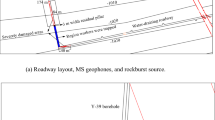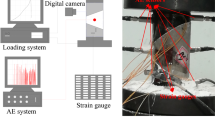Abstract
The characteristics of energy liberation, crack propagation, and shear slip during the process of failure and instability of coal-rock parting-coal structures (CRCS) with rough discontinuities were studied using numerical simulations and field microseismic (MS) observations. The influences of the joint roughness coefficient (JRC) of the discontinuities on the failure and instability characteristics of CRCS were also compared and analysed. Field observations were in good agreement with the numerical simulations. The following main conclusions are proposed: (1) the concentration of contact force first appeared at the obvious convex areas of the discontinuities, and crack propagation and slip along discontinuities developed gradually. The instability of slip increased gradually with stress loading/or unloading and there was clear periodic instability during slip of discontinuities; (2) the shear slip trend of discontinuities promoted the development and concentration of shear cracks near the rough areas, and then local slip near failure zones unlocked and induced the expansion of cracks into coal/rock. Among these, the unlocking or sudden increase in shear slip along rough discontinuities easily induced MS events with higher magnitude and source radius; (3) there was a key area for unlocking a slip along the rough discontinuities, which was usually located in an area with a high degree of concave convex, and the unlocking of shear slip easily induced an extremely high vibration velocity of coal/rock. Additionally, with the increase in the roughness of discontinuities, both the instantaneous and overall instability of the composite structure gradually increased; and (4) field observations confirmed that the higher concentration stress induced frequent fracture and shear slip of CRCS under mining disturbance, and the different stress tension and pressure areas were generated along the advancing of working face owing to the difference in shear slip along rough discontinuities. This work is a supplement to our previous studies on the failure and instability characteristics of CRCS with smooth discontinuities, which can be more helpful for understanding the mechanism of coal-rock dynamic disasters triggered by slip and instability of CRCS near coal seam bifurcations in coal mines.
Highlights
-
Evolution characteristics of stress, crack and shear slip of coal-rock parting-coal structures with rough discontinuities were studied.
-
Shear-slip unlocking conditions of rough discontinuities between coal and rock parting were researched.
-
Unlocking or sudden increase in shear slip along rough discontinuities promotes development and expansion of cracks.
-
Field investigations confirmed the shear slip and stress differential distribution characteristics in coal seam bifurcation zone.















Similar content being viewed by others
References
Bahaaddini M, Hagan PC, Mitra R, Hebblewhite BK (2015) Parametric study of smooth joint parameters on the shear behaviour of rock joints. Rock Mech Rock Eng 48:923–940
Bandis SC, Lumsden AC, Barton NR (1983) Fundamentals of rock joint deformation. Int J Rock Mech Min Sci Geomech Abstr 20:249–268
Barton N (1973) Review of a new shear-strength criterion for rock joints. Eng Geol 7(4):287–332
Barton N, Choubey V (1977) The shear strength of rock joints in theory and practice. Rock Mech 10(1/2):1–54
Berger EJ, Mackin TJ (2014) On the walking stick-slip problem. Tribol Int 75:51–60
Bürgmann R (2018) The geophysics, geology and mechanics of slow fault slip. Earth Planet Sc Lett 495:112–134
Byerlee JD (1970) The mechanics of stick-slip. Tectonophysics 9:475–486
Carr JR, Warriner JB (1989) Relationship between the fractal dimension and joint roughness coefficient. Bull Assoc Eng Geol 24:253–263
Chakrabarti BK, Stinchcombe RB (1999) Stick-slip statistics for two fractal surfaces: a model for earthquakes. Physica a 270(1–2):27–34
Du F, Wang K, Wang GD, Jiang YF, Xin CP, Zhang X (2018) Investigation of the acoustic emission characteristics during deformation and failure of gas-bearing coal-rock combined bodies. J Loss Prevent Proc 55:253–266
Fairhurst CE, Hudson JA (1999) Draft ISRM suggested method for the complete stressstrain curve for intact rock in uniaxial compression. Int J Rock Mech Min Sci Geomech Abstr 36(3):281–289
Ficker T (2017) Fractal properties of joint roughness coefficients. Int J Rock Mech Min Sci 94:27–31
Ge YF, Kulatilake PHSW, Tang HM, Xiong CR (2014) Investigation of natural rock joint roughness. Comput Geotech 55:290–305
Ge YF, Xie ZG, Tang HM, Du B, Cao B (2021) Determination of the shear failure areas of rock joints using a laser scanning technique and artificial intelligence algorithms. Eng Geol 93:106320
Ghazvinian A, Sarfarazi V, Schubert W, Blumel M (2012) A study of the failure mechanism of planar non-persistent open joints using PFC2D. Rock Mech Rock Eng 45:677–693
Grasselli G (2006) Manuel Rocha medal recipient shear strength of rock joints based on quantified surface description. Rock Mech Rock Eng 39:295–314
Hamdi J, Souley M, Scholtès L, Heib MA, Gunzburger Y (2017) Assessment of the energy balance of rock masses through discrete element modelling. Procedia Engineering 191:442–450
Itasca Consulting Group Inc (2014) PFC Manual, Version 5.0 (Minneapolis, Minnesota)
Kaproth BM, Marone C (2013) Slow earthquakes, preseismic velocity changes, and the origin of slow frictional stick-slip. Science 341(6151):1229–1232
Khazaei C, Hazzard J, Chalaturnyk R (2016) Discrete element modeling of stick-slip instability and induced microseismicity. Pure Appl Geophys 173:775–794
Kulatilake PHSW, Balasingam P, Park J, Morgan R (2006) Natural rock joint roughness quantification through fractal techniques. Geotech Geol Eng 24:1181–1202
Kulatilake PHSW, Malama B, Wang J (2001) Physical and particle flow modeling of jointed rock block behavior under uniaxial loading. Int J Rock Mech Min Sci 38:641–657
Leeman JR, Saffer DM, Scuderi MM, Marone C (2016) Laboratory observations of slow earthquakes and the spectrum of tectonic fault slip modes. Nat Commun 7:11104
Li S, Dun LI (2011) Numerical simulation analysis of covering rock strata as mining steep inclined coal seam under fault movement. T Nonferr Metal Soc 21:556–561
Liu XG, Zhu WC, Yu QL, Chen SJ, Li RF (2017) Estimation of the joint roughness coefficient of rock joints by consideration of two-order asperity and its application in double-joint shear tests. Eng Geol 220:243–255
Liu XG, Zhu WC, Zhang PH, Li LK (2021) Failure in rock with intersecting rough joints under uniaxial compression. Int J Rock Mech Min Sci 146:104832
Liu Y, Dai F, Xu NW, Zhao T, Feng P (2018) Experimental and numerical investigation on the tensile fatigue properties of rocks using the cyclic flattened Brazilian disc method. Soil Dyn Earthq Eng 105:68–82
Liu Y, Lu CP, Liu B, Xiao ZY, Zhang H (2019a) Slip and instability mechanisms of coal-rock parting-coal structure (CRCS) under coupled dynamic and static loading. Energy Sci Eng 7(6):2703–2719
Liu Y, Lu CP, Zhang H, Wang HY (2019b) Numerical investigation of slip and fracture instability mechanism of coal-rock parting-coal structure (CRCS). J Struct Geol 118:265–278
Li Y, Huang R (2015) Relationship between joint roughness coefficient and fractal dimension of rock fracture surfaces. Int J Rock Mech Min Sci 75:15–22
Li ZL, Dou LM, Cai W, Wang GF, Ding YL, Kong Y (2016) Mechanical analysis of static stress within fault-pillars based on a Voussoir beam structure. Rock Mech Rock Eng 49:1097–1105
Lu CP, Dou LM, Zhang N, Xue JH, Wang XN, Liu H, Zhang JW (2013) Microseismic frequency-spectrum evolutionary rule of rockburst triggered by roof fall. Int J Rock Mech Min Sci 64:6–16
Lu CP, Liu GJ, Liu Y, Zhang H (2019) Mechanisms of rockburst triggered by slip and fracture of coal–parting–coal structure discontinuities. Rock Mech Rock Eng 52:3279–3292
Lyu Z, Rivière J, Yang Q, Marone C (2019) On the mechanics of granular shear: the effect of normal stress and layer thickness on stick-slip properties. Tectonophysics 763:86–99
Petukhov IM, Linkov AM (1979) The theory of post failure deformations and the problem of stability in rock mechanics. Int J Rock Mech Min Sci Geomech 16:57–76
Saadat M, Taheri A, Kawamura Y (2021) Investigating asperity damage of natural rock joints in polycrystalline rocks under confining pressure using grain-based model. Comput Geotech 135:104144
Singh HK, Basu A (2016) Shear behaviors of ‘real’ natural un-matching joints of granite with equivalent joint roughness coefficients. Eng Geol 211:120–134
Song H, Zuo J, Liu H, Zuo S (2021) The strength characteristics and progressive failure mechanism of soft rock-coal combination samples with consideration given to interface effects. Int J Rock Mech Min Sci 138:104593
Souley M, Homand F (1996) Stability of jointed rock masses evaluated by UDEC with an extended Saeb-Amadei constitutive law. Int J Rock Mech Min Sci Geomech Abstr 33:233–244
Tal Y, Goebel T, Avouac JP (2020) Experimental and modeling study of the effect of fault roughness on dynamic frictional sliding. Earth Planet Sc Lett 536:116133
Tan YL, Guo WY, Gu QH, Zhao TB, Yu FH, Hu SC, Yin YC (2016) Research on the rockburst tendency and AE characteristics of inhomogeneous coal-rock combination bodies. Shock Vib 2016:9271434
Thomas MY, Avouac JP, Gratier JP, Lee JC (2014) Lithological control on the deformation mechanism and the mode of fault slip on the longitudinal valley fault, Taiwan. Tectonophysics 632:48–63
Wang JC, Jiang FX, Meng XJ, Wang XY, Zhu ST, Feng Y (2016) Mechanism of rock burst occurrence in specially thick coal seam with rock parting. Rock Mech Rock Eng 49:1953–1965
Wang Z, Gu LL, Shen MR, Zhang F, Zhang GK, Wang X (2019) Shear stress relaxation behavior of rock discontinuities with different joint roughness coefficient and stress histories. J Struct Geol 126:272–285
Yang SQ, Huang YH, Ranjith PG, Jiao YY, Ji J (2015) Discrete element modeling on the crack evolution behavior of brittle sandstone containing three fissures under uniaxial compression. Acta Mech Sin 31:871–889
Yang ZY, Di CC, Yen KC (2001) The effect of asperity order on the roughness of rock joints. Int J Rock Mech Min Sci 38(5):745–752
Yao W, Cai YY, Yu J, Zhou JF, Liu SY, Tu BX (2019) Experimental and numerical study on mechanical and cracking behaviors of flawed granite under triaxial compression. Measurement 145:573–582
Yin PJ, Ma JJ, Yan CG, Huang LC (2019) Estimation of the shear strength of fractured Gosford sandstone based on fractal theory and numerical modelling. J Pet Sci Eng 182:106278
Zhang L, He CR (2013) Frictional properties of natural gouges from Longmenshan fault zone ruptured during the Wenchuan Mw7.9 earthquake. Tectonophysics 594:149–164
Zhang L, He CR, Liu YJ, Lin J (2017) Frictional properties of the South China Sea oceanic basalt and implications for strength of the Manila subduction seismogenic zone. Mar Geol 394:16–29
Zhao TB, Guo WY, Lu CP, Zhao MG (2016) Failure characteristics of combined coal-rock with different interfacial angles. Geomech Eng 11(3):345–359
Zhao YL, Zhang CS, Wang YX, Lin H (2021) Shear-related roughness classification and strength model of natural rock joint based on fuzzy comprehensive evaluation. Int J Rock Mech Min 137:104550
Zhao ZH, Wang WM, Yan JX (2013) Strain localization and failure evolution analysis of soft rock-coal-soft rock combination model. J Appl Sci 13(7):1094–1099
Zhou XP, He Y, Shou YD (2021) Experimental investigation of the effects of loading rate, contact roughness, and normal stress on the stick-slip behavior of faults. Tectonophysics 816:229027
Acknowledgements
We gratefully wish to acknowledge the collaborative funding support from the National Natural Science Foundation of China (51574225, 52104102) and the Fundamental Research Funds for the Central Universities (2021QN1001). In addition, the data in this manuscript are available from authors.
Author information
Authors and Affiliations
Corresponding author
Ethics declarations
Conflict of Interest
The authors declare that there is no conflict of interests regarding the publication of this paper.
Additional information
Publisher's Note
Springer Nature remains neutral with regard to jurisdictional claims in published maps and institutional affiliations.
Rights and permissions
Springer Nature or its licensor holds exclusive rights to this article under a publishing agreement with the author(s) or other rightsholder(s); author self-archiving of the accepted manuscript version of this article is solely governed by the terms of such publishing agreement and applicable law.
About this article
Cite this article
Liu, Y., Lu, CP., Zhang, XF. et al. Failure and Instability Characteristics of Coal-Rock Parting-Coal Structures with Rough Discontinuities. Rock Mech Rock Eng 55, 7063–7080 (2022). https://doi.org/10.1007/s00603-022-03011-6
Received:
Accepted:
Published:
Issue Date:
DOI: https://doi.org/10.1007/s00603-022-03011-6




